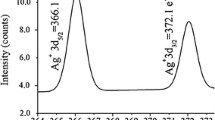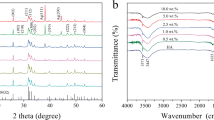Abstract
The restoration of defective bone tissue and complications related to surgery and fracture site infection are major concerns in orthopedic surgeries. However, it is crucial to develop osteoconductive and bacteriostatic composites. Chitosan/nano hydroxyapatite (CT/n-HAp) powder containing of Ag and Si were prepared by an in situ hybridization method. The aim of this work was to elucidate the effect of size, surface roughness, and chemical structure of mentioned nanocomposites on cytotoxicity and bacteriostatic activity via human osteoblast cells and Escherichia Coli, respectively. Particle size, surface roughness, reactive oxygen specious production, and bioactivity of nanocomposites were investigated by X ray diffraction, atomic force microscopy, DPPH assay, and SEM/UV–Visible spectrophotometer, respectively. Bacterial colony counting test, MTT assay and lactate dehydrogenase (LDH) release were performed as bacteriostatic and biocompatibility tests. The results showed that CT/n-HAp/Ag with smaller particle size in the range of 1–22.6 nm (10.00 ± 0.09 nm) than CT/n-HAp/Si in the range of 3–72.5 nm (18.00 ± 0.14 nm) exhibits higher cell viability and bacteriostatic activity, and less LDH release from cell plasma membrane. Integration of Ag into the nanocomposite hindered the release of Ag+ ions and restricts cytotoxic potential on cells. Higher cytotoxic effect of CT/n-HAp/Si might be related to proton concentration derived from nanocomposite and its chemical structure. In conclusion, the strong bone regeneration potential of CT/n-HAp and good biocompatibility and bacteriostatic activity of CT/n-HAp/Ag make it as potential bacteriostatic bone filler in site of infected bone fracture.





Similar content being viewed by others
References
Albano C, Perera R, Cataño L, Karam A, González G (2011) Prediction of mechanical properties of composites of HDPE/HA/EAA. J Mech Behav Biomed 4(3):467–475
Batandier C, Fontaine E, Kériel C, Leverve XM (2002) Determination of mitochondrial reactive oxygen species: methodological aspects. J Cell Mol Med 6(2):175–187
Best S, Zou S, Brooks RA, Huang J, Rushton N, Bonfield W (2008) The osteogenic behaviour of silicon substituted hydroxyapatite. Key Eng Mat 361:985–988
Bhattacharjee S, de Haan LH, Evers NM, Jiang X, Marcelis AT, Zuilhof H et al (2010) Role of surface charge and oxidative stress in cytotoxicity of organic monolayer-coated silicon nanoparticles towards macrophage NR8383 cells. Part Fibre Toxicol 7(1):25
Botelho C, Brooks R, Best S, Lopes M, Santos J, Rushton N et al (2006) Human osteoblast response to silicon-substituted hydroxyapatite. J Biomed Mater Res A 79:723–730
Carlisle EM (1980a) A silicon requirement for normal skull formation in chicks. J Nutr 110:352–359
Carlisle EM (1980b) Biochemical and morphological changes associated with long bone abnormalities in silicon deficiency. J Nutr 110:1046–1056
Chen W, Liu Y, Courtney HS, Bettenga M, Agrawal CM, Bumgardner JD et al (2006) In vitro anti-bacterial and biological properties of magnetron co-sputtered silver-containing hydroxyapatite coating. Biomaterials 27:5512–5517
Chen W, Oh S, Ong A, Oh N, Liu Y, Courtney H et al (2007) Antibacterial and osteogenic properties of silver-containing hydroxyapatite coatings produced using a sol gel process. J Biomed Mater Res A 82(4):899–906
Choi O, Hu Z (2008) Size dependent and reactive oxygen species related nanosilver toxicity to nitrifying bacteria. Environ Sci Technol 42(12):4583–4588
Giovanardi D (2014) Cranial osteomyelitis due to E. coli infection in commercial layers. Vet Rec 18;174(3):76
Heinemann S, Coradin T, Worch H, Wiesmann H, Hanke T (2011) Possibilities and limitations of preparing silica/collagen/hydroxyapatite composite xerogels as load-bearing biomaterials. Compos Sci Technol 71(16):1873–1880
Hui Q, Chen Z, Zhiquan A, Yao J, Yaochao Z, Jiaxin W, Xin L, Bing H, Xianlong Z, Yang W (2014) Silver nanoparticles promote osteogenic differentiation of human urine-derived stem cells at noncytotoxic concentrations. Int J Nanomed 9:2469–2478
Hwang S, Jeong S (2011) Electrospun nano composites of poly (vinyl pyrrolidone)/nano-silver for antibacterial materials. J Nanosci Nanotechnol 11(1):610–613
Itoh S, Kikuchi M, Takakuda K, Nagaoka K, Koyama Y, Tanaka J et al (2002) Implantation study of a novel hydroxyapatite/collagen (HAp/col) composite into weight-bearing sites of dogs. J Biomed Mater Res 63(5):507–515
Jiang J, Huo K, Chen S, Xin Y, Xu Y, Wu Z (2009) Intracellular chromosome breaks on silicon surface. Biomaterials 30:2661–2665
Jongwattanapisan P, Charoenphandhu N, Krishnamra N, Thongbunchoo J, Tang I, Hoonsawat R et al (2011) In vitro study of the SBF and osteoblast-like cells on hydroxyapatite/chitosan–silica nanocomposite. Mater Sci Eng C 31:290–299
Khanna R, Katti KS, Katti DR (2010) In situ swelling behavior of chitosan–polygalacturonic acid/hydroxyapatite nanocomposites in cell culture media. Int J Polym Sci 1–12
Kim YS, Song MY, Park JD, Song KS, Ryu HR, Chung YH et al (2010) Subchronic oral toxicity of silver nanoparticles. Part Fibre Toxicol 7:20
Lok C-N, Ho C-M, Chen R, He Q-Y, Yu W-Y, Sun H et al (2006) Proteomic analysis of the mode of antibacterial action of silver nanoparticles. J Proteome Res 5(4):916–924
Luo X, Zhang L, Morsi Y, Zou Q, Wang Y, Gao S et al (2011) Hydroxyapatite/polyamide 66 porous scaffold with an ethylene vinyl acetate surface layer used for simultaneous substitute and repair of articular cartilage and underlying bone. Appl Surf Sci 257(23):9888–9894
Miyaji F, Kono Y, Suyama Y (2005) Formation and structure of zinc-substituted calcium hydroxyapatite. Mater Res Bull 40(2):209–220
Mo A, Liao J, Xu W, Xian S, Li Y, Bai S (2008) Preparation and antibacterial effect of silver–hydroxyapatite/titania nanocomposite thin film on titanium. Appl Surf Sci 255(2):435–438
Morones JR, Elechiguerra JL, Camacho A, Holt K, Kouri JB, Ramírez JT et al (2005) The bactericidal effect of silver nanoparticles. Nanotechnology 16(10):2346
Murugan R, Panduranga Rao K (2002) Biodegradable coralline hydroxyapatite composite-gel using natural alginate. Key Eng Mater 240:407–410
Murugan R, Rao KP (2003) Graft polymerization of glycidylmethacrylate onto coralline hydroxyapatite. J Biomater Sci Polym Ed 14(5):457–468
Muzzarelli R (2011) CT composites with inorganics, morphogenetic proteins and stem cells, for bone regeneration. Carbohydr Polym 83:1433–1445
Notodihardjo FZ, Kakudo N, Kushida S, Suzuki K, Kusumoto K (2012) “Bone regeneration with BMP-2 and hydroxyapatite in critical-size calvarial defects in rats. J Craniomaxillofac Surg 40(3):287–291
Pang X, Zhitomirsky I (2008) Electro deposition of hydroxyapatite–silver–CT nanocomposite coatings. Surf Coat Technol 202:3815–3821
Pape HC, Evans A, Kobbe P (2010) Autologous bone graft: properties and techniques. J Orthop Trauma 24:S36–S40
Pratsinis A, Hervella P, Leroux J-C, Pratsinis SE, Sotiriou GA (2013) Toxicity of silver nanoparticles in macrophages. Small 15:2576–2584
Roy M, Bandyopadhyay A, Bose S (2011) Induction plasma sprayed nano hydroxyapatite coatings on titanium for orthopaedic and dental implants. Surf Coat Technol 205(8):2785–2792
Sadat-Shojai M, Atai M, Nodehi A, Khanlar LN (2010) Hydroxyapatite nanorods as novel fillers for improving the properties of dental adhesives: synthesis and application. Dent Mater 26(5):471–482
Sahithi K, Swetha M, Prabaharan M, Moorthi A, Saranya N, Ramasamy K et al (2010) Synthesis and characterization of nanoscale hydroxyapatite-copper for antimicrobial activity towards bone tissue engineering applications. J Biomed Nanotechnol 6:333–339
Santos HA, Riikonen J et al (2010) In vitro cytotoxicity of porous silicon microparticles: effect of the particle concentration, surface chemistry and size. Acta Biomater 6(7):2721–2731
Saravanan S, Nethala S, Pattnaik S, Tripathi A, Moorthi A, Selvamurugan N (2011) Preparation, characterization and antimicrobial activity of a bio-composite scaffold containing chitosan/nano-hydroxyapatite/nano-silver for bone tissue engineering. Int J Biol Macromol 49(2):188–193
Shokrgozar M, Farokhi M, Rajaei F, Bagheri M, Azari S, Ghasemi I (2010) Biocompatibility evaluation of HDPE-UHMWPE reinforced β-TCP nanocomposites using highly purified human osteoblast cells. J Biomed Mater Res A 95:1074–1083
Sionkowska A, Kozłowska J (2010) Characterization of collagen/hydroxyapatite composite sponges as a potential bone substitute. Int J Biol Macromol 47(4):483–487
Stoesser N, Pocock J, Moore CE, Soeng S, Hor P, Sar P (2013) The epidemiology of pediatric bone and joint infections in Cambodia, 2007–11. J Trop Pediatr 59(1):36–42
Tan F, Naciri M, Dowling D, Al-Rubeai M (2012) In vitro and in vivo bioactivity of CoBlast hydroxyapatite coating and the effect of impaction on its osteoconductivity. Biotech adv 30(1):352–362
Tavakol S, Kashani IR, Azami M, Khoshzaban A, Tavakol B, Kharrazi S et al (2012) In vitro and in vivo investigations on bone regeneration potential of laminated hydroxyapatite/gelatin nanocomposite scaffold along with DBM. J Nanopart Res 14(12):1–14
Tavakol S, Khoshzaban A, Azami M, Kashani IR, Tavakol H, Yazdanifar M, Sorkhabadi SM (2013a) The effect of carrier type on bone regeneration of demineralized bone matrix in vivo. J Craniofac Surg 24(6):2135–2140
Tavakol S, Nikpour M, Amani A, Soltani M, Rabiee S, Rezayat S et al (2013b) Bone regeneration based on nano-hydroxyapatite and hydroxyapatite/chitosan nanocomposites: an in vitro and in vivo comparative study. J Nanopart Res 15(1):1–16
Thian E, Huang J, Best S, Barber Z, Bonfield W (2006a) Silicon-substituted hydroxyapatite thin films: Effect of annealing temperature on coating stability and bioactivity. J Biomed Mater Res A 78:121–128
Thian ES, Huang J, Best SM, Barber ZH, Brooks RA, Rushton N et al (2006b) The response of osteoblasts to nanocrystalline silicon-substituted hydroxyapatite thin films. Biomaterials 27:2692–2698
Thompson ML, Kateley LJ (1999) The Nernst equation: determination of equilibrium constants for complex ions of silver. J Chem Educ 76(1):95
Wagoner Johnson AJ, Herschler BA (2011) A review of the mechanical behavior of CaP and CaP/polymer composites for applications in bone replacement and repair. Acta Biomater 7(1):16–30
Yamaguchi I, Tokuchi K et al (2001) Preparation and microstructure analysis of chitosan/hydroxyapatite nanocomposites. J Biomed Mater Res 55(1):20–27
Zyman Z, Rokhmistrov D, Ivanov I, Epple M (2006) The influence of foreign ions on the crystal lattice of hydroxyapatite upon heating. Mater Wiss Werkst Technol 37(6):530–532
Acknowledgments
This work was supported by grant from Student’s Scientific Research Center, Tehran University of Medical Sciences, Tehran, Iran.
Author information
Authors and Affiliations
Corresponding authors
Rights and permissions
About this article
Cite this article
Tavakol, S., Nikpour, M.R., Hoveizi, E. et al. Investigating the effects of particle size and chemical structure on cytotoxicity and bacteriostatic potential of nano hydroxyapatite/chitosan/silica and nano hydroxyapatite/chitosan/silver; as antibacterial bone substitutes. J Nanopart Res 16, 2622 (2014). https://doi.org/10.1007/s11051-014-2622-9
Received:
Accepted:
Published:
DOI: https://doi.org/10.1007/s11051-014-2622-9




